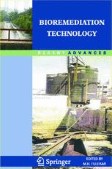Search
Search Results
-
Strategies for Decolorization and Detoxification of Pulp and Paper Mill Effluent
The manufacture of pulp and paper is a resource-intensive industry that requires a large quantity of water, energy, and lignocellulosic materials of...
-
Decolorization of Azo Dyes by White Rot Fungi
White rot fungi (WRF) produce various isoforms of extracellular peroxidases (lignin peroxidase-LiP and manganese peroxidase-MnP) and phenoloxidases...
-
Decolorization of Synthetic Dyes and Textile Effluents by Basidiomycetous Fungi
Decolorization of six synthetic dyes and two raw textile effluents (A and B) by eight basidiomycetous fungi was investigated. Among eight...
-
Decolorization of Azo Dyes by Immobilized Fungi
Decolorization has recently become an area of major scientific interest as indicated by the large quantity of related research reports. During the...
-
Impacts of long-term inorganic and organic fertilization on lignin in a Mollisol
PurposeFertilization is an essential management method to maintain and increase soil organic carbon (SOC) content in agroecosystems. Fertilizer...

-
Single factorial experimental design for decolorizing anaerobically treated distillery spent wash using cladosporium cladosporioides
This study presents the standardization of nutrient concentration, pH and temperature required to decolorize the anerobically treated distillery...
-
Development of a novel fungal consortium for the treatment of molasses distillery wastewater
In India, cane molasses–based distilleries are major production centers of ethanol. These industries release a dark brown colored effluent known as...

-
Biodegradation of Synthetic Dyes—A Review
The contamination of soils and waters by dye-containing effluents is of environmental concern. Due to the increasing awareness and concern of the...

-
Factors Affecting the Complete Mineralization of Azo Dyes
Azo dyes are complex compounds generally recalcitrant to biodegradation. From their catabolism several toxic and carcinogenic compounds are formed,...
-
Decolorization of Azo Dyes by Yeasts
Azo dyes are synthetically produced organic molecules and represent the largest group of commercial dyes. Industrial use for coloring purposes...
-
Lignins and Polyphenols in Bioremediation
Bioremediation by definition is concerned with the fate and, if necessary, removal of unwanted organic chemicals from soil and/or water. At present,...
-
Peroxidase mediated decolorization and remediation of wastewater containing industrial dyes: a review
In this article an effort has been made to review literature based on the role of peroxidases in the treatment and decolorization of a wide spectrum...
-
Fundamental study of degradation of dichlorodiphenyltrichloroethane in soil by laccase from white rot fungi
This research describes application of laccase from white-rot fungi (polyporus) to remove dichlorodiphenyltrichloroethane in soil. The degradation...
-
A comprehensive overview of elements in bioremediation
Sustainable development requires the development and promotion of environmental management and a constant search for green technologies to treat a...

-
Degradation of phenols in olive oil mill wastewater by biological, enzymatic, and photo-Fenton oxidation
Background, aim, and scopeOlive oil mill wastewater (OOMW) environmental impacts minimization have been attempted by develo** more effective...
-
Noncovalent immobilization of manganese peroxidases from P. chrysosporium on carbon nanotubes
Manganese peroxidases (MnP) from Phanerochaete chrysosporium were adsorbed onto multi-walled carbon nanotubes (MWNT). Four different loadings of MnP...
-
Effect of leachate loading rate and incubation period on the treatment efficiency by T. versicolor immobilized on foam cubes
This study focuses on treatment of landfill leachate in column experiments by immobilized Trametes versicolor on polyurethane foam, collected from...
-
Effects of ECF-Kraft pulp mill effluent treated with fungi (Rhizopus oryzae) on reproductive steroids and liver CYP1A of exposed goldfish (Carassius auratus)
The toxicity of bleached Kraft pulp mill effluents (BKME) is usually attributed to chemical compounds which are produced and released throughout...

-
Decolouration of azo dyes by Phanerochaete chrysosporium immobilised into alginate beads
Background, aim and scopeBecause of high discharged volumes and effluent composition, wastewater from the textile industry can be considered as the...

